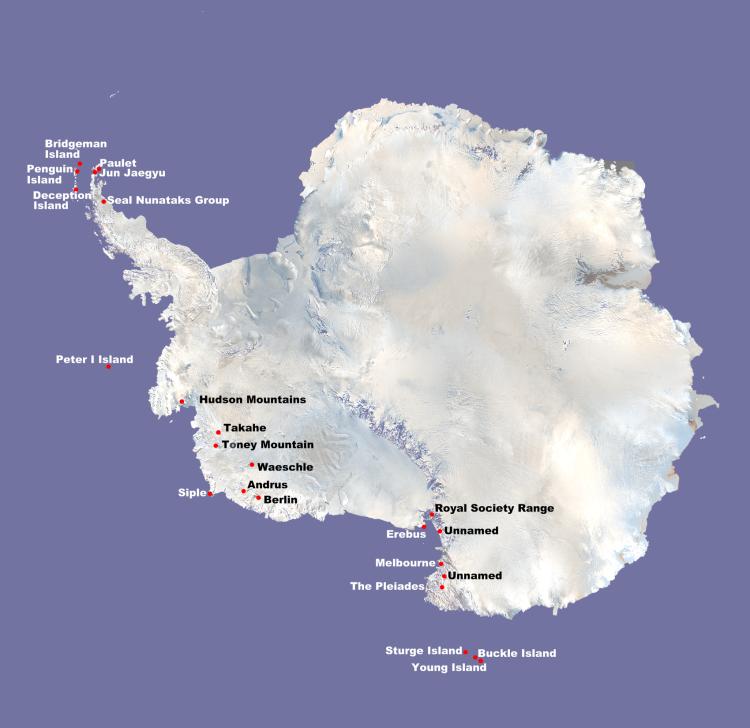
Above: Mt Erebus, Antarctica,picture by Sean Brocklesby
A press release today by the University of Washington makes a claim that Antarctica is warming and has been for the last 50 years:
“The study found that warming in West Antarctica exceeded one-tenth of a degree Celsius per decade for the last 50 years and more than offset the cooling in East Antarctica.”
…
“The researchers devised a statistical technique that uses data from satellites and from Antarctic weather stations to make a new estimate of temperature trends.”
…
“People were calculating with their heads instead of actually doing the math,” Steig said. “What we did is interpolate carefully instead of just using the back of an envelope. While other interpolations had been done previously, no one had really taken advantage of the satellite data, which provide crucial information about spatial patterns of temperature change.”Satellites calculate the surface temperature by measuring the intensity of infrared light radiated by the snowpack, and they have the advantage of covering the entire continent. However, they have only been in operation for 25 years. On the other hand, a number of Antarctic weather stations have been in place since 1957, the International Geophysical Year, but virtually all of them are within a short distance of the coast and so provide no direct information about conditions in the continent’s interior.
The scientists found temperature measurements from weather stations corresponded closely with satellite data for overlapping time periods. That allowed them to use the satellite data as a guide to deduce temperatures in areas of the continent without weather stations.
…
Co-authors of the paper are David Schneider of the National Center for Atmospheric Research in Boulder, Colo., a former student of Steig’s; Scott Rutherford of Roger Williams University in Bristol, R.I.; Michael Mann of Pennsylvania State University; Josefino Comiso of NASA’s Goddard Space Flight Center in Greenbelt, Md.; and Drew Shindell of NASA’s Goddard Institute for Space Studies in New York City. The work was supported by grants from the National Science Foundation.
Anytime Michael Mann gets involved in a paper and something is “deduced” it makes me wary of the veracity of the methodology. Why? Mann can’t even correct simple faults like latitude-longitude errors in data used in previous papers he’s written.
But that’s not the focus of the moment. In that press release they cite NASA satellite imagery. Let’s take a look at how the imagery has changed in 5 years.
NASA’s viewpoint - 2004
NASA’s viewpoint - 2009
Earth’s viewpoint - map of Antarctic volcanoes

Click for larger image
From the UW paper again:
“West Antarctica is a very different place than East Antarctica, and there is a physical barrier, the Transantarctic Mountains, that separates the two,” said Steig, lead author of a paper documenting the warming published in the Jan. 22 edition of Nature.But no, it just couldn’t possibly have anything at all to do with the fact that the entire western side of the Antarctic continent and peninsula is dotted with volcanoes. Recent discovery of new volcanic activity isn’t mentioned in the paper at all.
From January 2008, the first evidence of a volcanic eruption from beneath Antarctica’s ice sheet has been discovered by members of the British Antarctic Survey.
The volcano on the West Antarctic Ice Sheet began erupting some 2,000 years ago and remains active to this day. Using airborne ice-sounding radar, scientists discovered a layer of ash produced by a ’subglacial’ volcano. It extends across an area larger than Wales. The volcano is located beneath the West Antarctic ice sheet in the Hudson Mountains at latitude 74.6°South, longitude 97°West.

Thanks to wattsupwiththat








































The next question is the cause of warming :
ReplyDeleteIs it natural or man made?
See:
http://sansteknologi.blogspot.com/
wuih kayaknya dingin buanget yah kang di sana, tapi kalo global warming apakah masih dingin nantinya?
ReplyDelete